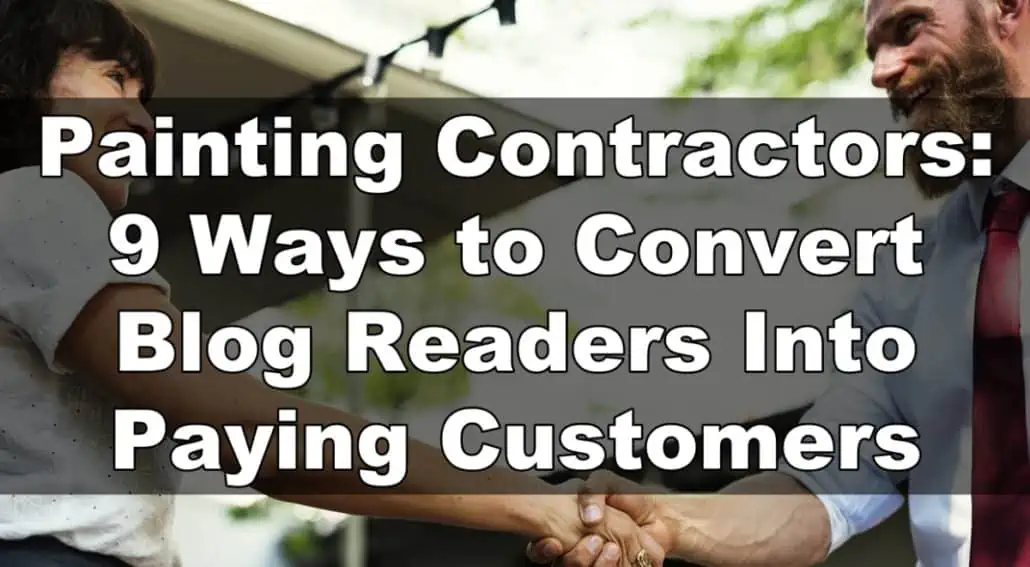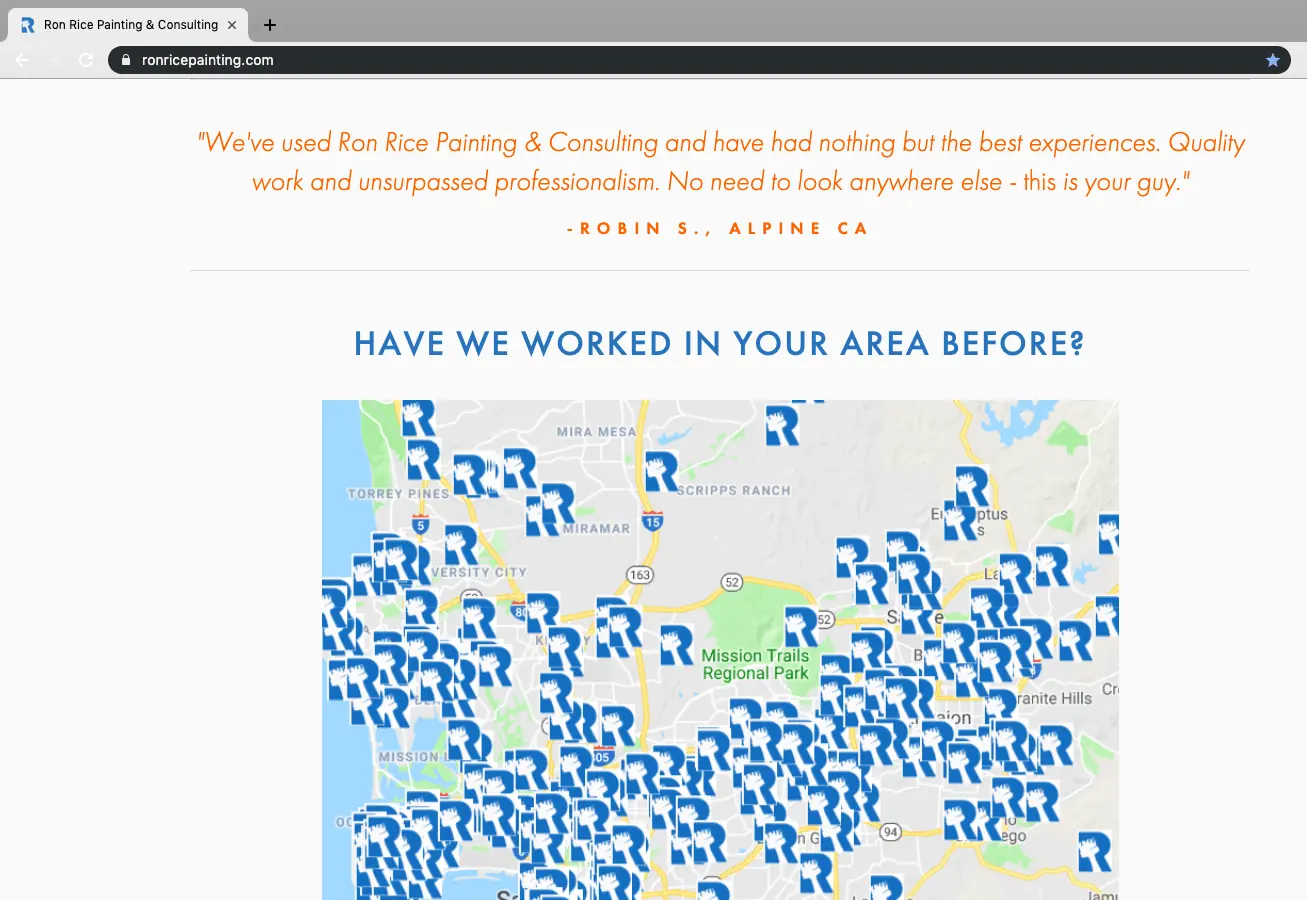
Painting Contractors: 9 Proven Ways to Convert Blog Readers Into Paying Customers
“I have a blog, but how do I use it to get actual paying customers?”
The two main reasons you have a blog for your painting business is:
- To increase awareness about your painting company and services
- To close more sales
It’s proven that painting businesses with a blog receive 2 times more website visitors than those who don’t have a blog at all.
However, if you can’t convert those site visitors into paying customers, then blog traffic becomes just another fancy statistic.
The main objective of a consistently updated blog is to pump out that SEO and get your website ranked higher and higher on Google.
Then once you receive lots of visitors to your website, the attention and recognition are great, but the ultimate success of your painting blog is measured by the rate at which it turns visitors into paying customers.
The question is, “How?”
Here are nine proven strategies you can use to turn more visitors on your painting blog into actual paying customers:
1. Write Blog Posts That Directly Answer Objections
When updating your painting blog, you probably already know you need to write blog posts that are valuable to your target market.
If you don’t know who your target market is, download this free worksheet by DYB Coach to figure it out!
Take some time to understand your target customer to create the most relevant content to them.
For instance, if you’re a commercial painting contractor doing business with companies or business owners, most of your customers probably view painting as a necessary inconvenience.
You could create a post explaining how your painting crew strictly stays within their given time frame, follows the project guidelines, and are willing to work at odd hours, days, or seasons, to eliminate the inconveniences and any hesitance they may have.
If you need help drumming up some ideas for what to write about, here’s 101 blog post ideas for painting contractors.
Other readers might be interested in your services but have something holding them back…
Some may include:
• Is this painter the right fit for my painting needs?
• Will the painter use high-quality paint products?
• Is this the best price for my project, or can I get it cheaper somewhere else?
• Can I trust the painting crew in my house?
Once you understand the hesitance that some of your customers have, go ahead and create posts that address them.
For the above examples, you could create titles like:
• “7 Reasons You Should Hire (Your Company name) for Commercial Painting/Residential Painting/Cabinet Staining… etc.”
• “Here is Why We Only Use Professional-Grade Paint Products”
• “5 Things to Consider When Hiring a Painting Contractor” –here, explain that value for money is more important than the total “cost” of the project, and why cheaper is not always better.
• “Should You Trust a Painting Contractor in Your House Alone?” –mention how you do background checks on each of your crew members, use in-house staff, and you have worked with your crew for years.
This is also where having a Customer Map on your website comes in handy when trying to establish instant trust.
To understand what might be keeping some of your blog visitors from purchasing your services, interview a few of your previous and current customers or clients.
2. Eliminate Distractions for Your Readers
I would imagine your primary goal is to have your site visitors book a painting estimate or at least contact you inquiring about your services.
Keep your primary goal in mind and let all the blog posts, videos, and other materials focus on that.
If your blog post and the page has lots of outbound links, social media widgets, pop-ups, badges, and advertising, you might be distracting and overwhelming your readers.
Make it clear that you want your visitors to book an estimate or maybe subscribe to your monthly newsletter.
Additionally, simplify the menu and footer, minimize distractions on the sidebar, use at most two calls to action (CTA) per blog post, and be 100% clear about what action you want the visitors to take.
For example, at the end of a blog post you may say something like…
“We hope these tips help you in choosing paint colors for your next painting project! Here at (company name), we offer reliable, efficient and high-quality residential painting services. If you would like to give us a try, simply book a FREE estimate here (booking link) or call us today at (phone number) for more details.”
3. Show Them Exactly How You Can Help Them
Unlike selling defined products, it might not always be 100% clear to each visitor what your painting services entail and exactly how you can help them.
The best way to clear that up is to first start by explaining what exactly it is that you do.
Telling them that you offer “Eco-Painting and Lead Paint Remediation” services, for instance, might set you apart –but your customer may not always know what that means…
While at it, explain why the visitor might need your services and how they will benefit from them.
What kind of results should they expect?
If you have some examples of what you’ve done before, this is the best time to display them with some before and after pictures.
At the end of the blog, be sure to include a call to action for interested visitors to book your service.
4. Turn Them into Paying Customers via Your Email List
Most of the casual readers on your blog are primarily there for information, asking them directly to buy your services might not always work.
Email marketing is a supplementary way to nurture casual blog readers into paying customers.
The email list will allow you to get in touch with interested site-visitors, it will help you get to know a little more about each other, and also let them see if your services match their needs.
Subscribing to a newsletter is low-risk and ‘harmless’ enough for most people, unlike making a financial commitment right away or giving out their credit card info to a new site.
To increase chances of signup, offer a valuable freebie in exchange for their email address.
For example, “25 Questions a Painting Contractor Should Be Able to Answer ‘YES’ to, Before You Hire Them” is a resource in the DYB Cafe, which is free to members and is something that would pique the interest of someone visiting your site.
There’re numerous programs, widgets, and plugins to help you build and manage an email list.
If you don’t already have an Email Marketing Software, we can help!
Tip: To make your email subscription and campaign a success, offer something significant, and temptingly valuable in return.
This could be a FREE eBook, FREE 1-Hour Touch-Up, FREE front door re-finish, ‘Ultimate home maintenance checklist,’ etc…
5. Create Content According To the Buying Cycle
Unless it’s an absolute emergency, customers typically go through a standard buying cycle.
The buying cycle for most painting customers takes the following general pattern:
i. Need – customers know they need to do something about their home or property, they’re just not 100% sure what yet. For instance, a homeowner might be aware of mildew on the exterior siding, but they’re not sure what to do or which contractor to consult.
ii. Initial research – the customer tries to search for a solution online. In the above mildew example, they might not be sure whether they need a full exterior repainting or a simple pressure washing. By reading your post, e.g., “Exterior Home Mildew: Do’s and Don’ts,” they might recognize that exterior washing alone might not eliminate the problem, and a full exterior repaint is long overdue.
iii. Final research – The customer has found a solution, and all that’s left is choosing where to purchase it.
iv. Purchase – The customer books an estimate and approves the quote (…and maybe pays for a deposit)
Your post should be able to move the customer through all the four stages; from validating their need, recommending the best solution, to offering yourself as the best painter and leading them to book your services.
To achieve this, your blog post needs to be informative and authoritative so you can keep them engaged throughout the buying cycle.
6. Show Real Reviews And Testimonials
“People don’t buy products/services; they buy the brand.”
This statement is a popular saying within the ‘marketing’ and ‘sales’ circles.
Quite honestly, it carries a lot of weight and truth if you consider the buying habits of a typical consumer.
People need to know the brand they’re dealing with, and unfortunately, this doesn’t always happen on the “About Us” page as you would imagine.
Your potential customers need social proof to gain more trust in you and gauge whether or not you’re reliable.
Some of your previous customers who are happy with your work can be a great source of testimonials.
At the end of the project, ask your customer if they can offer a video testimonial of their experience with your service.
Capture your customers’ sentiments along with the work you did for them and share this on your blog under the “Testimonials” tab.
Generally, both videos and photos of your previous projects should do the trick.
Regarding reviews, request from previous ‘A’ or ‘B’ customers to leave a review about your company on trusted platforms like Google My Business, and share this on your blog.
7. Add a Deliberate Call-To-Action
If the blog posts on your painting blog don’t end with a specific call to action, you’re leaving money on the table.
What do you want your visitors to do at the end of your post?
For most painting contractors, booking a painting estimate is the primary goal.
But you may also be offering a freebie, for example “free front door re-finishing” in exchange for their contact info.
Call-to-actions are important elements of your painting blog because they increase your chances of turning visitors into paying customers.
If you don’t tell them exactly how you can help them and what they should do next, they will ‘Purchase’ the solution from a different painter, even though they learned about it from your blog post –refer to point 5 above.
Use terms like ‘Contact us today,’ ‘Book a FREE estimate now’, or ‘Claim Your FREE Checklist Now,’ etc.
8. Make Your Content Easier To Read
Not every visitor on your painting blog will read your content.
And when they do, most people don’t read everything…
Think about it –when was the last time you read an entire blog post word-for-word on someone else’s business blog?
Most visitors will scan for pieces of information that capture their attention.
For this reason, your content should be visually appealing and ‘scannable’ by casual readers.
This allows them to get your message which encourages them to convert into buyers.
Here’s how to make your content ‘scannable’:
• Provide facts
• Use an active or present voice
• Keep your paragraphs short (1-2 sentences)
• Include appealing visuals (photos & videos)
• Use bullet points and numbered lists
• Use sub-titles
9. Don’t Be too Pushy
While it’s critical to be deliberate and explicit about what you want your visitors to do, being too pushy can, believe it or not, push them away.
At the same time, entirely avoiding self-promotion can be counter-productive.
Just be honest, transparent, and ask for what you want, only AFTER you’ve delivered value.
It’s quite the balancing act, but with a little practice or help from an experienced painting blog writer, you can convert the visitor into a paying customer.
The best approach is to use most of your blog post to offer advice and information, and communicate value/benefits, and only a small section for a call to action.
Doing this will win their trust and position you as an authoritative service provider.
The Bottom Line
Your painting blog is a powerful and free tool you can use to create awareness about your painting services, attract more traffic to your content, and turn the blog visitors into paying customer.
The end result of this is more estimate bookings and increased revenue to your painting business!
If you need any help creating engaging, informative, and high-quality painting blog posts that turn visitors into paying customers, DYB Virtual can help.
Check out our Monthly Search Engine Optimized (SEO) blog post packages for painting contractors and see what works for you.
If you have any questions please book a meeting with me here or shoot me an email at Nadia@DYBVirtual.com and I’ll be happy to answer any of your questions!
Happy blogging! (:

